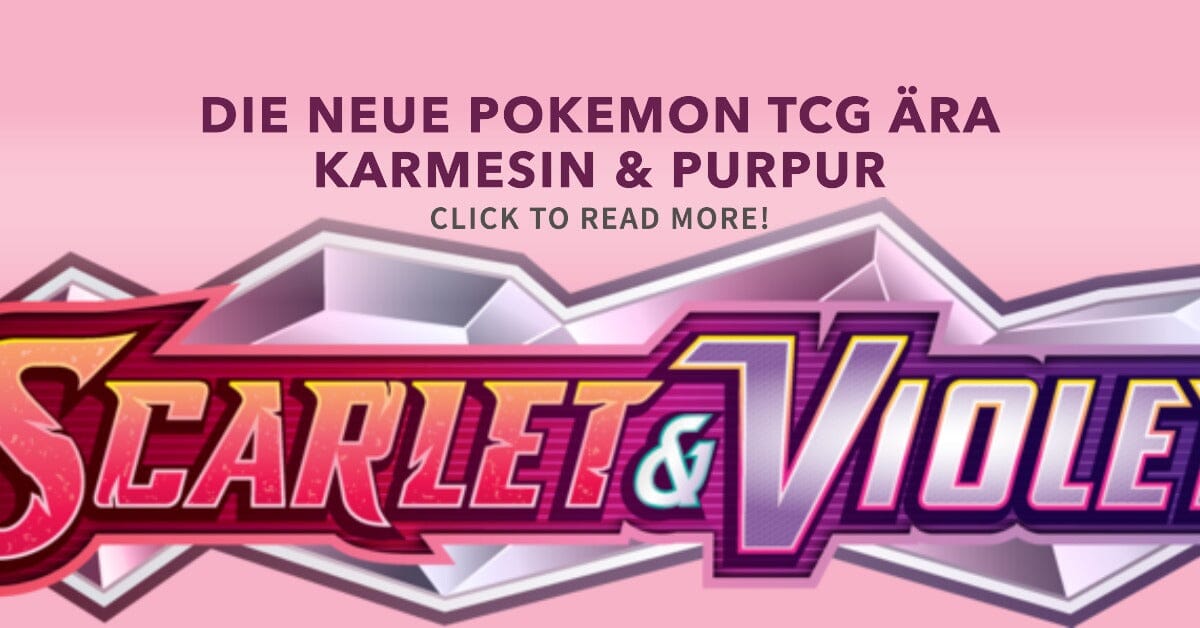The time has come: The era of "Sword & Shield" is over and the sets of the new "Crimson & Purpur" era are in the starting blocks. With a generational change, there are always changes to the sets, especially when it comes to card design. This is nothing new and happens every time a new generation starts. So let's take a look at what's changing and what you can look forward to!
The edge of the map
One pleasant change is that the yellow card border that has been present on our cards since the beginning of the TCG is gone. This finally brings the maps into line with the simpler Japanese map borders after 23 years. In the Japanese sets, the gray card border was introduced back in 2010, during the "Black & White" era.
Set & Rarity Icons
The previous set symbols on the cards are no longer used. Instead, the set abbreviation now appears on the cards, as it did in the Japanese TCG. This abbreviation will also be used in the future to identify the respective language of the card. For example, the first English set will be called "SV1EN" while the German "SV1DE" is used as an abbreviation.
There are also changes to the rarity icons. They are now much more distinguishable from one another, and it becomes easier to tell a card's rarity. Instead of only distinguishing between common ●, uncommon ◆ and rare ★, the rarity is now even more differentiated. You can find a detailed overview in a separate blog post here .
Reverse holo cards
The reverse holo cards remain with us, but change their visual appearance. Instead of the simple columnar pattern that always reflected the Pokemon card type, the pattern is now more vibrant and resembles a mosaic. Here, too, the respective card type can be recognized quickly.
Also of interest is that each pack now contains two reverse cards, unless it includes an Illustration Rare (AR) or Special Illustration Rare (SAR). In this case, a reverse slot is used.
The holo effect
The holo effect also changes. Instead of the vertical "lines" from the "Sword & Shield" era, the holocards now get a new foiling. In addition, as with the Japanese cards, the holo effect can also be found on the edge and thus appears more valuable than the previous yellow edge, which covered the holo effect.
Also interesting is that each booster pack will contain at least one holocard, which means there will be at least one "hit card". However, this will make holographic cards "bulk" which makes opening the packs even more appealing compared to before!
The holo effect on promo cards
For the promo cards, we get both the standard Crimson & Crimson-era foil and the Sword & Shield-era Galaxy foil. However, it is still unclear when which holo variant will be used. Presumably, blisters will receive the Galaxy foil, while promos from "pre-release kits" or store promotions will use the standard foil.
Rainbow Cards
Some may like this point, others may dislike it - tastes are known to differ. But it doesn't change the fact: Rainbow cards are a thing of the past as of the Crimson & Crimson era, at least for now. Whether they will return soon or not is unclear. The reason for the abolition of the rainbow cards is also unknown, but is probably due to the general unpopularity. Neither Pokemon nor trainer cards will appear as rainbow variants until further notice.
New card types
The elimination of the rainbow cards makes room for new card types. On the one hand, illustration rares (AR) are standardized in the sets, on the other hand, we now seem to expect special illustration rares (SAR) in every set. Both can claim a Reverse Holo slot, so the best combo of a pack will be: Reverse + SAR + SR/UR. However, the V, VMAX, and VSTAR cards are also leaving with this set, with EX cards returning in a new guise.
EX cards
EX Cards are similar in appearance to V Cards from the Sword & Shield era, except they are now EX Cards. However, if a Pokemon on the EX card is teracrystallized, that EX card also has structure, making it similar to a VMAX or VSTAR card.
The EX Fullart cards also differ from each other depending on whether the Pokemon is teracrystallized or not. Teracrystallized Pokemon have a plain background and a different holo effect (see SAR cards).
Special Illustration Rares (SAR)
The SARs differ from the normal ARs in that they have more elaborate artwork and structure. They also have a different holo effect. As the Japanese card prices already show, this card type should be the new Chase cards.
Conclusion
Although the set has not yet been released, you can already guess from the numerous pictures and openings what the quality of the new cards will be like. The maps seem to experience an increase in quality: the structures appear finer and the corners are now more round than square. However, the printline problem remains, both in the Japanese and Western variants. Printlines run across almost every map variant.
However, this is not a final verdict on the quality of the cards. There will always be outliers showing that there are both very clean maps and poorer quality examples.
All in all, many exciting innovations and changes in the Pokemon TCG await us in the "Crimson & Crimson" era. With new card types, modified holo effects, and the departure of rainbow cards, it's exciting to see how the gameplay and card collection will continue to evolve.



